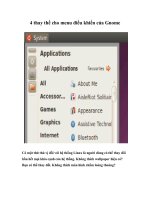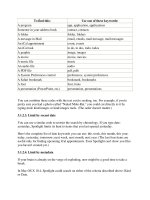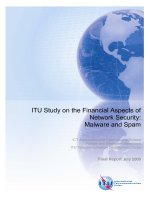Taking spam off the menu
Bạn đang xem bản rút gọn của tài liệu. Xem và tải ngay bản đầy đủ của tài liệu tại đây (596.21 KB, 14 trang )
Chapter 5
Taking SPAM
Off the Menu
Chapter 5
Taking SPAM
Off the Menu
Tessa was thrilled beyond expression on Easter holidays when her Dad finally relented
and let her open her own email account. She checked it 4 and 5 times a day—eager to
have mail of her own. Everyday it seemed she was giving her new address to someone
else—friends at school, kids from her church youth group, even new friends she’d met
online. To make sure that everyone could find her, she added her name to online direc-
tories and even posted her new address on her family’s webpage.
The first month or so, everything was wonderful. Tessa felt connected to the world.
Then she started to hear from some of its darker inhabitants.
First, Tessa began getting boring stupid emails intended for grownups. Silly people
trying to sell her stuff no real 13-year-old could possibly want. Some of them even tried
to get her to sign up for credit cards. Tessa tried to get rid of the
emails, sending replies to links
that were supposed to remove
her from the mailing lists.
The number of emails
just kept increasing.
After a while, the mail
Tessa was getting got
creepy. She didn’t re-
ally understand a lot
of the things people
were trying to sell her,
but they reminded her
60
Chapter 5
a lot of that day in Health class she always tried to stay home. And again, the number of
emails kept rising.
By the last week of school, Tessa was getting so much junk email that she couldn’t find
the messages from her friends in the pile. She gave up and quit using her email.
As summer started, Tessa’s dad signed her up for a new email account. This time, he
defined filters to automatically throw away the messages she wouldn’t want. Now, Tessa’s
being very careful who she gives her new email address to.
Like Tessa, most teens are overwhelmed by email they don’t want and really
shouldn’t have to see. The sheer number of unsolicited email messages also wastes
incredible amounts of computer resources. In 2009, a Microsoft security report
concluded that 97% of all email messages are SPAM. How is that even possible?
Thankfully, not all of that SPAM manages to get through. For every SPAM email
you pitch, your Internet Service Provider (ISP) has blocked several more before
they even land in your mailbox. Unfortunately, that still leaves a ton of SPAM in
circulation.
5.1 Email and SPAM
SPAM is the electronic equivalent of junk mail. That’s email you didn’t ask for (or
agreed to accept without realizing) and almost always don’t want. Some SPAM
is junk email from legitimate companies trying to sell you their product. Others
are junk email from less-than-respectable companies trying to do the same. Taken
together, all those spammers eat up a ton of bandwidth.
5.1.1 What Is SPAM?
If you’re curious, SPAM is actually a canned meat product. If you haven’t had it,
the taste is somewhere in between ham and corned beef. However, in computer
usage the term SPAM comes from an early 1970’s Monty Python comedy skit. In
the skit, a couple is trying to order breakfast without SPAM in a restaurant where
every meal comes with SPAM in some form. The overall feeling is that
SPAM
is
everywhere, in everything, and you just can’t escape it. Junk email definitely gener-
ates similar feelings.
Taking SPAM Off the Menu
61
SPAM Unsolicited email messages, also called electronic junk mail.
A surprising amount of SPAM is for products that are either clearly illegal or on
pretty shaky ground. For example, a common source of SPAM is ads for online
degree programs. In fairness, there are a number of excellent, highly respected
online degree programs—particularly for master’s degrees. However, most of these
schools don’t flood the net with SPAM advertising their programs. The schools
that do tend to be—you guessed it—“non-accredited” universities. In evaluating
any item or service you find advertised in unsolicited email, remember to “Caveat
Emptor.” That’s Latin for “Let the buyer beware!” At the risk of being obvious,
any college degree that you can get over the Internet while attending no classes
and taking no tests of any kind is clearly not cool. This type of company is called a
diploma mill. A diploma issued by such a school is not a real college degree. More
important, using such a fake diploma to get a job or obtain a promotion is illegal.
5.1.2 Isn’t SPAM Illegal?
That’s a good question without an easy an-
swer. Truthfully, some SPAM is illegal. Some
isn’t. It’s also very difficult to tell the dif-
ference. Because SPAM is so disruptive, the
U.S. Congress addressed it specifically in the
CAN-SPAM Act of 2003, then reviewed and
extended that legislation in 2005. So, CAN-
SPAM is still in effect (and still ineffective).
Like most government initiatives, this effort
was named by an acronym—CAN-SPAM
actually stands for Controlling the Assault of
Non-Solicited Pornography And Marketing.
Its goal was to reduce the amount of SPAM
by making senders legally liable. In fact, its
definitions actually legalized a good bit of SPAM, leading opponents to begin call-
ing it the “I Can SPAM” Act. What the bill did define as illegal was any unsolic-
ited electronic messages that didn’t include a valid subject line and header, the real
postal address of the mailer, a clear label marking the content as Adult-only if it
was, and an opt-out mechanism.
Felony First
In 2004, Jeremy Jaynes became
the first person convicted of
felony SPAM. During his peak,
Jaynes sent upwards of 10 million
messages a day, mostly for “get
rich quick” schemes and various
fake goods and services.
Sadly, the Virginia law under
which he was convicted was later
overturned—a reversal that was
upheld in March 2009 when the
U.S. Supreme Court refused to
reinstate the law.
62
Chapter 5
It didn’t work. Three years after the passage of this act, SPAM had increased to
comprise 75% of all email messages, and less than one half of one percent of those
messages actually complied with the provisions of the CAN-SPAM Act.
Interestingly, the first person arrested under the CAN-SPAM Act was a teenager,
18-year-old Anthony Greco of Cheektowaga, New York. Overall, however, arrests
under CAN-SPAM have been rare and successful prosecutions even rarer.
The big problem with CAN-SPAM is the opt-out mechanism. An opt-out mecha-
nism is a way for the recipient to get off the mailing list. You’ve no doubt seen
these in junk email that you’ve received. The general format is:
If you would prefer not to receive further information from Spammer-of-Your-Choice,
please reply back to this message with “Remove” in the subject line.
You may also have seen the format:
If you would like to stop receiving our advertisements or believe this message was sent
in error, you can visit our subscription management page.
To add more substance to their claims of legitimacy, spammers often actually cite
the CAN-SPAM Act in their opt-out clauses:
This email is a commercial advertisement sent in compliance with the CAN-SPAM Act. We
have no desire to send you information that is not wanted, therefore, if you wish to be
excluded from future mailings, please use the link at the bottom of the page.
The general idea is always the same. To get off the mailing list, you need to visit
the spammer’s website or send them an email. The problem is that as soon as you
do so, you have verified that they have a real, valid email address and that their
messages are getting through. If the spammer plays by the rules, this works well.
If they don’t, you have just told them that your
email address is worth selling. Because many
spammers don’t play by the rules, experts
strongly recommend that you NEVER reply
to unsolicited email or visit links included in
SPAM. Doing so can greatly increase, rather
than decrease, the amount of SPAM you receive
in the future.
Taking SPAM Off the Menu
63
5.2 Spoofing
A spoof is a parody of something familiar. In its pure form, a spoof is usually a
pretty good joke. Weird Al Yankovic has made a career out of writing musical
spoofs of popular songs. One of his best was a 1983 parody of Michael Jackson’s
hit Beat It called Eat It. The music video for this one was especially funny.
Email spoofing isn’t nearly so funny.
Email spoofing
happens when the person
who sends you an email—nearly always a SPAM message—pretends to be some-
one else. Spammers are able to “spoof” messages by defining fake headers that
include phony routing information. Real routing information is the part of your
email that defines your email account’s Internet address. These are the numbers
that allow email servers to deliver your mail. You can think of the routing defini-
tion as very much like a postal address. If the address isn’t valid, the email doesn’t
get through. Phony routing information hides the real address of the person send-
ing an email message.
5.2.1 Spoofed Addresses
When you send an email message to someone else, the message sent always begins
with a header that includes your name and email address. Those items are defined
in your email software as the “Display name” and “Display email address”. By
changing those settings, you can actually display anything you want. Of course,
tracing an email spoofed this easily would be fairly simple. Spammers also insert
fake routing information; this makes it appear that the email was sent through one
or more systems that most likely never touched it. Tracing messages spoofed with
fake routing information is MUCH more difficult and sometimes impossible.
Spoofed email An email message containing a fake From: address making it impos-
sible to tell where it was actually sent from.
One of the reasons that spoofing email is fairly easy is because email headers are
created using
SMTP (Simple Mail Transfer Protocol)
, and SMTP lacks authen-
tication. One way to limit spoofing is to use digital signatures with your email.
We’ll talk about digital signatures in Chapter 8, Safe Cyber Shopping.
SMTP (Simple Mail Transfer Protocol) The Internet rules used to send and
create email messages.









